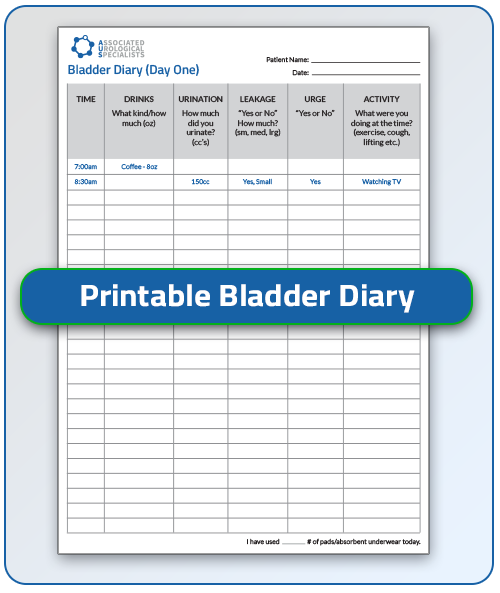Urinary Incontinence
What is urinary incontinence?
Incontinence is the involuntary loss of urine and it can have many different causes. Under normal circumstances, the bladder fills with urine and maintains a low pressure until the bladder gets full. Once full, it triggers signals to the brain and then when ready to urinate, your brain tells the bladder neck to open, the urethral sphincter to relax, and the bladder to contract which results in urination and emptying of the bladder. In patients with urinary incontinence, however, there are problems with urine storage in the bladder, bladder emptying during urination, or a combination of both.
There are two main types of urinary incontinence:

Stress urinary incontinence (SUI)
Stress urinary incontinence (SUI) is when straining from activities such as coughing, sneezing, lifting, and standing causes leakage of urine.

Urge Urinary Incontinence (OAB)
Urge urinary incontinence, also known as overactive bladder (OAB), is when the bladder has involuntary strong urges that the patient cannot control and the urine can leak out before a bathroom is available. Learn more here.
If both types of incontinence are present, it is referred to as mixed urinary incontinence.
What causes urinary incontinence?
There are many different causes of urinary incontinence in both men and women. For women, weakening of the pelvic floor muscles from childbirth, prior pelvic surgery, chronic constipation, and hormonal changes after menopause all can lead to stress incontinence.
Involuntary bladder contractions leading to urge incontinence frequently occur with aging in both men and women, and in men, these bladder changes can be made worse by obstruction from prostate enlargement from BPH.
Incontinence can also be caused by other medical problems such as diabetes, stroke, multiple sclerosis, or spinal cord injuries. In men, stress incontinence can occur after surgery or radiation for the treatment of prostate cancer.
Female incontinence
Watch our own Dr. Ewa Blachowicz discuss the misconceptions and myths about female incontinence. She answers the #1 question woman wonder about most, 'How much leakage should a woman have?"
Male incontinence
Think an overactive bladder is just a woman's issue? Think again. Watch our own Dr. Jae Kim discuss how one out of three men will have some degree of bladder control issues over the age of 60.
How is incontinence evaluated?
The accurate diagnosis of incontinence begins with a detailed history including details such as when urine leakage occurs, does leakage occur at night, other medical problems, prior pregnancy, and prior surgery. A complete physical exam, including a pelvic exam for women and prostate exam for men, is important in diagnosing incontinence.
The evaluation may also include a test called urodynamics during which a small catheter is placed into the bladder that has a pressure monitor at the end. The bladder pressure is then measured as the bladder is filled and during urination. As the bladder is filling, the patient reports any strong sensations of the urge to urinate. While the bladder is full, the patient is asked to cough or strain to evaluate for stress incontinence. At the conclusion of the test, a tracing of the bladder pressure is printed and helps the urologist determine if the cause of the incontinence.
Download our Free Bladder Diary by clicking the image above.
How is incontinence treated?
The treatment of incontinence depends on the cause.
Stress Incontinence
Exercise
Stress incontinence is caused by an anatomic problem and often requires surgical intervention to cure it. However, one of the first treatments is to have the patient attempt to strengthen the urethral sphincter by performing Kegel exercises. If stress incontinence persists, there are several surgical options that we offer.
Bulking Agents
Bulking agents such as collagen can also be injected into the urethral sphincter to help and bulk and strength to reduce incontinence episodes. Read more about Bulkamid, a bulking agent, here.
Surgical Options
There are several minimally invasive sling procedures for both women and men with stress incontinence that place a synthetic mesh sling under the urethra to provide support and decrease the incontinence. If the incontinence is related to pelvic prolapse, surgical correction of the prolapsed can improve the incontinence.
Another surgical option, primarily used in men with persistent incontinence after prostate surgery, is called the artificial urinary sphincter. This is a mechanical device which includes a fluid filled cuff that wraps around the urethra and holds the urine in the bladder. When the bladder is full, a small pump is pressed which drains the fluid out of the cuff and the urine starts flowing out of the bladder.
Urge Incontinence
Medications
Urge incontinence can often be treated with a class of medications called anti-muscarinics. These medications work to relax the bladder muscle and help prevent the involuntary urges and contractions that lead to urge incontinence.
There are many different medications in this class but in general, the side effects are similar and include dry mouth, dry eyes, and constipation.
Surgical Options
Surgical options for urge incontinence include the placement of a sacral nerve stimulator InterStim® which sends impulses to the nerves to the bladder which helps decrease involuntary contractions.
Botulinum toxin, or BoTox, can also be injected into the bladder muscle to help decrease urgency and incontinence episodes.
Exercise
Pelvic floor physical therapy and biofeedback can also be utilized to help relax the pelvic floor muscles and decrease urgency.

Start enjoying life again
At Associated Urological Specialists, our experienced urologists and practitioners assess our patients and discuss treatment options with them. Their goal is to find the most effective plan that works best for each individual.
Our goal is to not have you always looking for where the nearest restroom is, wondering whether you can drive somewhere without having to stop, making it through an entire movie, or just being out with family or friends without having to suddenly leave.
Make an appointment today
Call us today or use the button below to schedule an OAB appointment.
Urinary Incontinence Appointments at AUS are in Chicago, Southside Chicago and Northwest Indiana.
Urinary Incontinence testing and diagnosis can be performed quickly at any of our AUS offices. They are conveniently located in Chicago, Chicago Ridge, Evergreen Park, Homewood, Orland Park, IL and Highland, IN.
Urinary Incontinence treatments are done best with AUS.
Patients have learned the most advanced urology procedures, like Overactive Bladder and Stress Urinary Incontinence treatments, are done at AUS. See us if you live in Alsip, Bedford Park, Blue Island, Bridgeview, Burbank, Calumet Park, Chicago Heights, Country Club Hills, Crestwood, Englewood, Glenwood, Harvey, Hickory Hills, Homer Glen, Matteson, Midlothian, Mokena, Oak Lawn, Oak Forest, Olympia Fields, Orland Hills, Park Forest, Roseland, South side, South Holland and Tinley Park. Patients treated successfully at AUS come from Bolingbrook, Brighten Park, Burnham, Burr Ridge, Calumet City, Countryside, Crystal Lawns, Crest Hill, Darien, Dolton, Fairmont, Frankfort, Gage Park, Gillets, Hammond, Hinsdale, Hyde Park, Ingalls Park, Lansing, Lynwood, La Grange, Lemont, Lockport, Munster, Palisades, Richton Park, Riverdale, Romeoville, Sauk Village, South Shore, South Chicago, Westmont, Whiting, Willowbrook and Woodridge.


